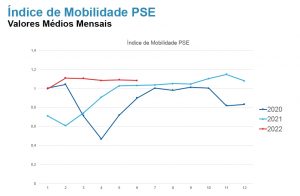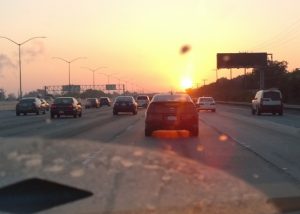
In the first half of 2022 we are experiencing mobility with new characteristics. In Greater Lisbon in particular, but also in Greater Porto, we see that most companies opt for a hybrid work model. This brings a vast set of changes in people’s lives and in the mobility of cities. Outside the big cities, the difference is practically not relevant, compared to 2019.
The PSE Mobility Panel measures mobility and allows the conclusion that, in the two main cities, there are now much less intense rush hours. Some journeys had a 50% reduction in time, when traveled on weekdays from 8 am to 10 am. On the other hand, there is more traffic between peak hours throughout the day compared to before. Another change was at the peak of the return home hour, which was anticipated by an hour and a half. There is no longer any justification for staying at the office later, when we can continue to work from home now, something we have become accustomed to.
All of this is the result of greater flexibility in working hours. It is due to this greater flexibility that there is more traffic between 10am and 6pm. That is, globally we make a greater number of trips, but of shorter duration, in the face of a pre-pandemic reality where there were, above all, “home-work-home” commuting movements.
As a result of this greater flexibility and greater permanence at home, there are also changes in purchasing behavior, in the places of purchase and even in the places of horeca consumption. PSE information also studies these aspects.
The PSE Mobility Index measures the mobility of Portuguese people aged 15 and over every day and at all times. In practice, it is a panel with a representative sample of the universe under study, who agreed to install an app that registers their mobility behavior at all times. This mobility index shows that in the first half of this year, the mobility of the Portuguese not only stabilized, after two troubled years, but is even higher than before the pandemic, as a result, as we said, of the greater flexibility of schedules that the telecommuting, or hybrid work, brings to people’s lives.
Greater mobility = More billboard audience
With more journeys made, that is, a greater number of journeys and, above all, more kilometers travelled, there is an increase in mobility of over 6.4%. As a result, we see that there is, for comparable periods, a 6% growth in the billboard audience, always in view of the reality before the pandemic. We use the same analysis periods for mobility and audience.
Outdoor advertising audience increased in 2022
After two years of confinement and limitations on mobility, in 2022 we finally have a stable weekly audience value for the “outdoor” and even already 6% higher than the pre-pandemic value, on average, in a similar comparison of dates and face inventory “billboard”.
Analyzing the first half of 2022, and only in monthly terms, we see great stability in outdoor advertising audience figures. Which also means that the mobility situation is also quite normalized, in the terms and with the characteristics that we have already described. We can now speak of a “new normal”. The monthly audience figures (GRPs) for the outdoor advertising sector were as follows:

Paulo Caldeira, PSE OOH Panel Manager




